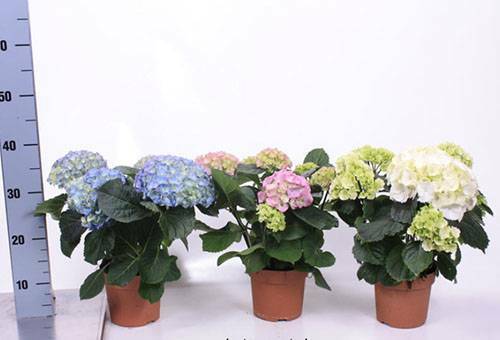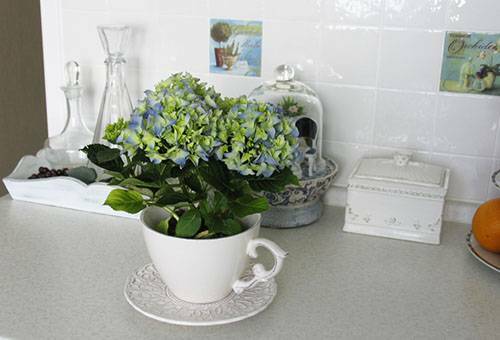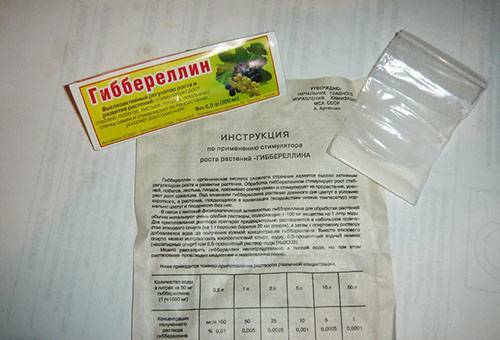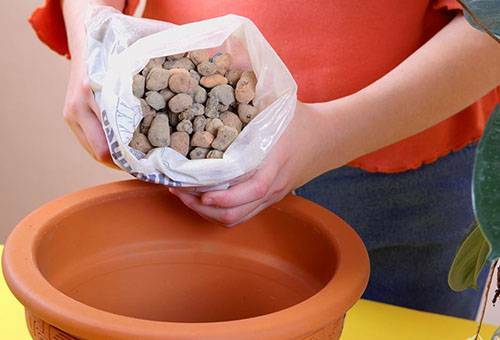Content:
- What should be the room temperature?
- Lighting
- Watering
- Fertilizers
- Transplanting
Hydrangea belongs to the genus of flowering plants, the Hortensian family and has about 90 species, which are bushes, lianas and low trees. These are perennials, distributed in the tropical and temperate zones of the planet and reaching two meters in height. Hydrangea can bloom from spring until autumn, which is why it is very popular for growing on a plot or at home. At home, a hydrangea is usually grown large-leaved.

This plant was first discovered in the late 17th century.on the island of Mauritius by a French expedition. In its composition was the prince Karl Nassau-Siegen from Germany, who throughout the expedition extolled the beauty of his sister Hortensia. In her honor, and was named an unknown exotic plant. However, later European botanists renamed it into a more suitable, in their opinion, name - Hydrangea( Hydrangea).If you translate this from Greek, you get: "a vessel with water."After all, hydrangeas, like all tropical plants, are very hygrophilous.
Hydrangea throws out a lot of straight, strongly branched shoots, ending in large caps of bright pink, red, white and blue inflorescences. In fact, its flowers are small in size and have colorless petals, and fabulously beautiful diamond-shaped petals belong to the bracts of the plant. The color of the petals depends on the composition of the soil: on the acidic soil they acquire a blue tint, on the alkaline one they are pinkish or lilac, and on the neutral soil the inflorescences are painted white or cream colored. This unique quality of the plant is due to its ability to accumulate aluminum. At present, varieties with a two-color colouration color, differing by smooth transitions from white to blue or pink, are derived for maintenance at home.

What should be the room temperature?
The usual room temperature at home, which is about + 18-22 ° C, is quite comfortable for the plant. Dangerous for him only a sharp change in temperature and drafts. In summer, the flower can be placed in the fresh air, in the taek. For example, on a balcony overlooking the north side, or on a site where the sun does not hit.
Council
Hydrangea is a deciduous plant, so with the onset of winter begins to discard the leaves. Do not think that she died and that she should be thrown away!
For winter, when the hydrangea enters a state of rest, it is better to put it in a cool dark room with an air temperature of 6-9 ° C.For this, a cellar, an attic or a glazed veranda is quite suitable in the home. Special care for it is not required, but you need to ensure that the soil in the pot does not dry out, and occasionally water the plant. It must restore its strength, expended on flowering. Otherwise, the next flowering period will come only after a year. Approximately in February-March hydrangea can be transferred to the house. But if the room is too hot, it will start to drop the leaves.

Lighting
Although the hydrangea needs good lighting, the scorching rays of the summer sun are badly transferred by it. If you put a pot with a flower on the windowsill, its leaves may begin to discolor. Therefore, the best care will provide a place about 4 meters from the window, where direct sunlight does not reach. But in February, when the plant wakes up from hibernation and starts releasing buds, it should be placed in the sunniest place - on the windows facing south.

Watering
In summer, the hydrangea needs a lot of watering, in autumn and spring - in a more moderate watering. Especially careful to be with watering in winter. Excessive moisture can lead to decay of the roots and the death of the plant. Hard chlorinated water from the tap at home is not to taste the flower. To ensure it is well maintained, water it with filtered or well-kept water. And you can freeze water, thaw it, wait until it reaches room temperature, and use it for irrigation.
advice If the soil is not acidic enough, the leaves of the plant begin to turn yellow. Therefore, it is sometimes necessary to water it with acidified water. To do this, in a liter of water, dissolve 5 drops of lemon juice.
If you live outside the city, you can collect rainwater and water the plant with it. And do not forget that care of the hydrangea includes its frequent spraying, since its native environment is characterized by high humidity. If the leaves of the plant begin to turn yellow, this indicates that the air in the room is too dry. For the same reason, the flower pot at home should not be placed near the battery.

Fertilizers
Since February, when the hydrangea room produces new shoots, the proper care of it is to feed it with organic fertilizers and minerals once every half a month. You can buy a complex fertilizer, designed specifically for flowering plants. In addition, you can water it with a weakly concentrated solution of potassium permanganate. Lack of nutrients can lead to the fact that hydrangea will cease to grow and produce buds. In winter, she does not need additional fertilizing.
Council
To stimulate the production of buds, the plant can be sprayed with gibberellin solution - 0.1 g per liter.
If you want inflorescences of different shades to bloom on one bush, fertilize each half of the soil in different ways.
For blue coloring, select appropriate care for the plant:
- add peat, sawdust or softwood to the soil;
- water this side of the pot with a solution consisting of 8 g of alum-alkali alum dissolved in a liter of water;
- inject iron salts into the soil( according to gardeners, even a common iron nail, which can be buried in the ground), will do it;
- You can spray the flower with a solution of 50 g of aluminum citric acid and 1 liter of water.
And in the other half of the soil add lime, chalk or ash, then the inflorescence will acquire a lilac or pink hue.

Transplant
Care of the flower at home is in its transplant every year - in the autumn, when flowering ends, or early spring. To do this, take a wide pot, because the roots tend to grow in the horizontal direction, rather than down. It is believed that along the circumference the roots occupy the same space as the ground part of the plant. In any case, by volume, the new capacity should be 1.5 times higher than the previous one.
Advice
When transplanting, you do not need to fill the root of the flower with ground, it should be level with the soil.
At the bottom you need to lay a thick layer of drainage. After that, room hydrangea is placed in a new pot with the same soil, and the voids are filled with fresh soil. For the soil, take half the pieces of sand, one part of the peat, one part of the leafy earth and two parts of the turf. To add humus is not recommended. In addition, topsoil can be covered with a layer of peat to prevent rapid evaporation of moisture. If you provide hydrangea good care at home, it will please you with its beauty and amaze your guests.
We recommend that you read the article: azalea care



